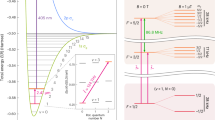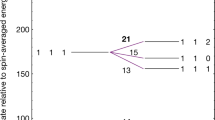Abstract
The systematic shifts of the transition frequencies in the molecular hydrogen ions are of relevance to ultra-high-resolution radio-frequency, microwave and optical spectroscopy of these systems, performed in ion traps. We develop the ab initio description of the interaction of the electric quadrupole moment of this class of molecules with the static electric field gradients present in ion traps. In good approximation, it is described in terms of an effective perturbation Hamiltonian. An approximate treatment is then performed in the Born–Oppenheimer approximation. We give an expression of the electric quadrupole coupling parameter valid for all hydrogen molecular ion species and evaluate it for a large number of states of H +2 , HD+, and D +2 . The systematic shifts can be evaluated as simple expectation values of the perturbation Hamiltonian. Results on radio-frequency, one-photon electric dipole (E1), and two-photon E1 transitions between hyperfine states in HD+ are reported. For two-photon E1 transitions between rotationless states, the shifts vanish. For a large subset of rovibrational one-photon transitions, the absolute values of the quadrupole shifts range from 0.3 to 10 Hz for an electric field gradient of 108 V/m2. We point out an experimental procedure for determining the quadrupole shift which will allow reducing its contribution to the uncertainty of unperturbed rovibrational transition frequencies to the 1 × 10−15 fractional level and, for selected transitions, even below it. The combined contributions of black-body radiation, Zeeman, Stark and quadrupole effects are considered for a large set of transitions, and it is estimated that the total transition frequency uncertainty of selected transitions can be reduced below the 1 × 10−15 level.

Similar content being viewed by others
Notes
Values of the hyperfine Hamiltonian coefficients for v = 5 and L = 5 levels were computed by V. Korobov and A. Bekbaev (private communication). The rotational g-factors for these levels were extrapolated from those of lower levels.
In addition to the neglect of excited electronic states, the calculations in Ref. [15] were performed taking into account only intermediate states with 0 ≤ v ≤ 4. Therefore, the polarizabilities of the v = 4, L = 2 level given in that paper deviate from the “correct” (within the chosen approximation) values by up to 1 at.u.
References
J.C.J. Koelemeij, B. Roth, A. Wicht, I. Ernsting, S. Schiller, Phys. Rev. Lett. 98, 173002 (2007)
U. Bressel, A. Borodin, J. Shen, M. Hansen, I. Ernsting, S. Schiller, Phys. Rev. Lett. 108, 183003 (2012)
V.I. Korobov, Z.-X. Zhong, Phys. Rev. A 86, 044501 (2012)
J.-P. Karr, A. Douillet, L. Hilico, Appl. Phys. B 107, 1043–1052 (2012). doi:10.1007/s00340-011-4757-z
A.K. Bekbaev, V.I. Korobov, M. Dineykhan, Phys. Rev. A 83, 044501 (2011). doi:10.1103/PhysRevA.83.044501
U. Fröhlich, B. Roth, P. Antonini, C. Lämmerzahl, A. Wicht, S. Schiller, in Seminar on Astrophysics, Clocks and Fundamental Constants, eds. by E. Peik, S. Karshenboim. Lecture Notes in Physics, vol. 648 (Springer, Berlin, 2004), p. 297
S. Schiller, V.I. Korobov, Phys. Rev. A 71, 032505 (2005)
M. Kajita, Phys. Rev. A 77, 012511 (2008)
D. Bakalov, V.I. Korobov, S. Schiller, Phys. Rev. A 82, 055401 (2010)
D. Bakalov, V.I. Korobov, S. Schiller, J. Phys. B At. Mol. Opt. Phys. 44, 025003 (2011)
D. Bakalov, V.I. Korobov, S. Schiller, J. Phys. B At. Mol. Opt. Phys. 45, 049501 (2012)
R.E. Moss, L. Valenzano, Mol. Phys. 100, 1527 (2002)
J.-P. Karr, S. Kilic, L. Hilico, J. Phys. B At. Mol. Opt. Phys. 38, 853 (2005)
J.C.J. Koelemeij, Phys. Chem. Chem. Phys. 13, 18844 (2011)
D. Bakalov, S. Schiller, Hyperfine Interact. 210, 25 (2012)
D.R. Bates, G. Poots, Proc. Phys. Soc. (Lond) Sec. A 66, 784 (1953)
J.M. Peek, A. Hashemi-Attar, C.L. Beckel, J. Chem. Phys. 71, 5382 (1979)
A.G. Posen, A. Dalgarno, J.M. Peek, At. Data Nucl. Data Tables 28, 265–277 (1983)
H.O. Pilón, D. Baye, J. Phys. B: At. Mol. Opt. Phys. 45, 065101 (2012). doi:10.1088/0953-4075/45/6/065101
D.M. Bishop, B. Lam, Chem. Phys. Lett. 134, 283–287 (1987)
D.M. Bishop, B. Lam, Mol. Phys. 65, 679–688 (1988)
A.K. Bhatia, R.J. Drachman, Phys. Rev. A 61, 032503 (2000)
H.O. Pilón, Quadrupole transitions in the bound rotational–vibrational spectrum of the deuterium molecular ion. arXiv:1302.5234v2
D. Bakalov, V.I. Korobov, Phys. Rev. A 57, 1662 (1998)
V.I. Korobov, D. Bakalov, Phys. Rev. Lett. 79, 3379 (1997)
A.R. Edmonds, Angular Momentum in Quantum, Mechanics. (Princeton University Press, Princeton, 1957)
V.I. Korobov, D. Bakalov, H.J. Monkhorst, Phys. Rev. A 59, R919 (1999)
D. Bakalov, V.I. Korobov, S. Schiller, Phys. Rev. Lett. 97, 243001 (2006)
V.I. Korobov, Phys. Rev. A 77, 022509 (2008)
H. Wind, J. Chem. Phys. 42, 2371 (1965)
V.I. Korobov, Phys. Rev. A 74, 052506 (2006)
H.J. Montgomery, Chem. Phys. Lett. 50, 455–458 (1977). doi:10.1016/0009-2614(77)80365-5
N. Huntemann, M. Okhapkin, B. Lipphardt, S. Weyers, C. Tamm, E. Peik, Phys. Rev. Lett. 108, 090801 (2012)
J. Shen, A. Borodin, M. Hansen, S. Schiller, Phys. Rev. A 85, 032519 (2012)
W.M. Itano, J. Res. Natl. Inst. Stand. Technol. 105, 829–837 (2000)
W.H. Oskay, S.A. Diddams, E.A. Donley, T.M. Fortier, T.P. Heavner, L. Hollberg, W.M. Itano, S.R. Jefferts, M.J. Delaney, K. Kim, F. Levi, T.E. Parker, J.C. Bergquist, Phys. Rev. Lett. 97, 020801 (2006). doi:10.1103/Phys.Rev.Lett.97.020801.
V.I. Korobov, A. Bekbaev, S. Schiller, et al., in preparation.
D. Bakalov, K. Bakalova, V.I. Korobov, H.J. Monkhorst, I. Shimamura, Phys. Rev. A 57, 3370 (1998)
P.E. Knowles, G.A. Beer, G.R. Mason et al., Phys. Rev. A 56, 1970 (1998)
Acknowledgments
This work has been supported by Grant SCHI 431/19-1 of the Deutsche Forschungsgemeinschaft. We are grateful to V.I. Korobov and A. Bekbaev for making available to us their results of the polarizabilities and of the hyperfine Hamiltonian coefficients.
Author information
Authors and Affiliations
Corresponding author
Rights and permissions
About this article
Cite this article
Bakalov, D., Schiller, S. The electric quadrupole moment of molecular hydrogen ions and their potential for a molecular ion clock. Appl. Phys. B 114, 213–230 (2014). https://doi.org/10.1007/s00340-013-5703-z
Received:
Accepted:
Published:
Issue Date:
DOI: https://doi.org/10.1007/s00340-013-5703-z




